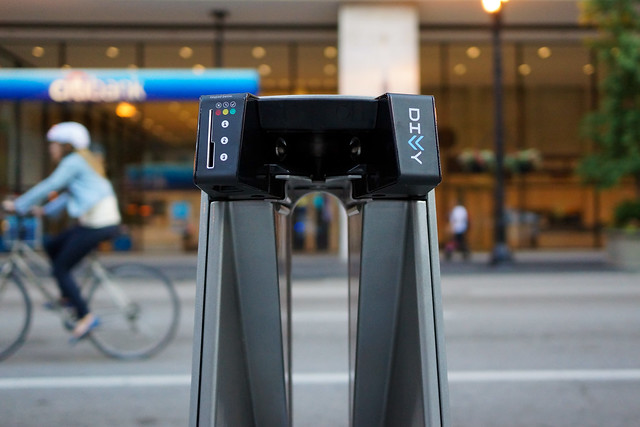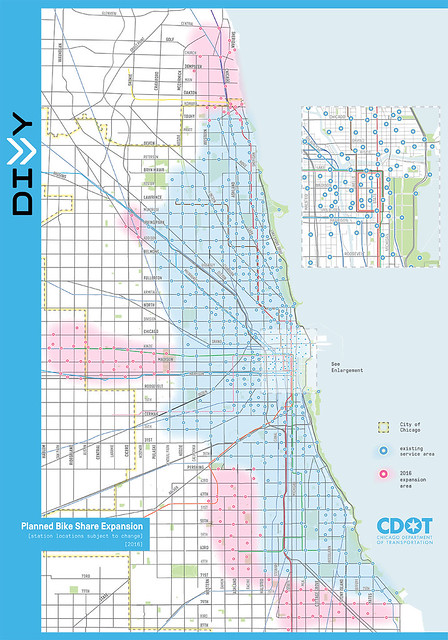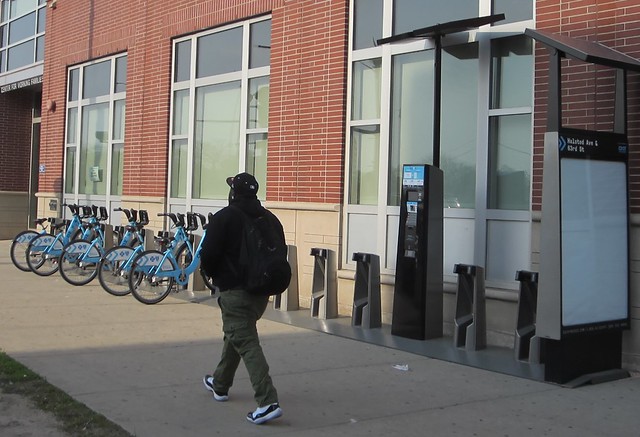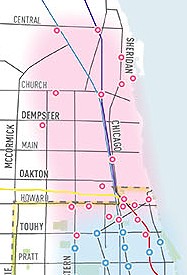These are exciting times for Divvy bike-share users as the city begins its second major expansion during the system’s three-year history. At the same time, Divvy is rolling out a bunch of new features and services, which they say will make the network function better than ever.
The expansion will add 85 more stations on the South, Southwest, West, Northwest, and Far North sides of the city, as well as 10 stations in Evanston and 13 in Oak Park. After the installations are completed, the system will include 584 stations and almost 6,000 bikes, maintaining its title as one of the largest in North America in terms of stations and cycles. The new coverage area is spread across 100 square miles, so Divvy will continue to be (as the city is fond of pointing out) the largest system on the continent in terms of service area.
The city released the new coverage area map last week, and a few interesting aspects spring to mind. As with last year’s expansion, the new areas generally get half-mile station spacing, as opposed to the quarter-mile spacing that was implemented downtown, and in dense, affluent North Lakefront neighborhoods, during the original 2013 rollout. The system is more convenient to use in areas with a higher station density, since it’s more likely there will be a station within a short walk of your trip’s origin and destination.
On the other hand, the new expansion helps make the system more equitable because most of the new Chicago neighborhoods served are low-to-moderate-income communities of color. The new communities include Burnside, Chatham, Greater Grand Crossing, Brighton Park, Englewood, East Garfield Park, West Garfield Park and Austin.
The Divvy service area has previously expanded outward from the Loop in a fairly logical manner, with a roughly equal amount of coverage north and south of Madison Street, although the service area didn’t expand nearly as far west. However, the new expansion map is a little odd, with panhandles of service stretching west to Oak Park and north to Evanston.
Since the two suburbs were willing to apply for state funding to pay for their stations, as well as chipping in the required 20 percent local match, it makes sense for the Chicago-owned system to expand in their directions. Although the city of Chicago doesn’t have to spend any money for those 23 suburban stations, their presence makes the system more useful for Chicagoans. For example, it will make it easier for West Side residents to access jobs in Oak Park.
But it would be understandable if residents of neighborhoods closer to downtown, but just outside of the panhandles, such as Lawndale, West Humboldt Park, and West Rogers Park, are upset because they got passed over this round in favor of the ‘burbs. The Chicago Department of Transportation would be wise to spread the word that no Chicago funding is being spent on the Oak Park and Evanston Stations.
There’s an odd little node of four new stations being installed on the Northwest Side in the 45th and 39th Wards this round. That’s likely because the local residents and aldermen have been strongly advocating to get stations.
45th Ward chief of Staff Owen Brugh says Alderman John Arena originally offered to spend tens of thousands of dollars in ward money to purchase stations. But in the end the ward only had to pay a few thousand dollars to build a concrete pad for a Divvy station by one of the local Metra stops. “We think there is a developing bike culture in this area, and if Divvies are there, people will use them,” Brugh said.
The Far North coverage is also a little weird. There’s a dense cluster of stations near Howard Street – two stations near the Howard Red Line stop are barely a block away from each other.
But the ten Evanston stations are mostly concentrated in the northern half of the city, and the locations don’t follow the typical grid pattern used in Chicago and Oak Park. This means there will be a “Divvy desert” in the heart of Evanston. For example, if you’re unlucky enough to live near Main Street and Asbury Avenue (the equivalent of Chicago’s Western Avenue), you’ve got a deal-breaking ten-minute walk to the nearest bike-share location.
This morning Divvy announced a number of new initiatives designed to make the system more convenient and pleasant to use. Over the past year they became the first major bike-share network in the country to use special “dynamic” rebalancing software. This new tool is intended to help Divvy staffers do a better job of redistributing the bikes, so that there are always available bikes and docks at your local station, or at least a short walk away.
This year Divvy is expanding its popular valet service, in which employees staff popular stations and check bikes into a corral area, to ensure you’ll be able to drop off your cycle. Previously this has been done downtown during rush hours and at special events. This year valet service will also be offered at popular neighborhood stations on weekdays, and at more summer festivals and events.
Divvy says they’ve worked with their supplier to replace bike parts with lower-maintenance components. They also say they’ve fine-tuned their bike maintenance protocols to reduce the number of cycles that are out of service at a given time.

A pet peeve of mine has been how slow the process of signing up for a day pass or getting a new ride code at a station has been –the kiosks changes screens change at a snail's pace. In May, Divvy partly solved that problem by introducing a new app that allows you to sign up for a membership and get a ride code via smartphone, without having to stand in line at a kiosk. Now they say they’re introducing a new kiosk interface this month that will be faster and easier to use.
Last but not least, Divvy is tackling the aesthetic issue of nasty-looking, peeling docks. They’re replacing those docks with more durable materials to help keep the stations from being an eyesore.
One more initiative I’d like to see that Divvy is not yet talking about is single-ride fares, a payment option that Washington, D.C.’s Capital Bikeshare launched last week, which is also being tried in other cities. CaBi allows you to purchase a 30-minute ride for $2, plus any accrued late fees. It’s a good option for people who want to try the system without committing to a 24-hour pass or annual membership, or just want to use the bikes once in a while to replace transit or cab trips.
Divvy should definitely explore this idea. for many people, a $2 single ride would be a welcome alternative to a $9.95 day pass.






